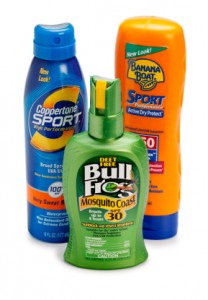Although most popular histories track the invention of sunscreen back to the 1930s, recently translated papyri and tomb walls in Egypt may push that date back by a few thousand years. Giving it a little thought, I guess it just makes sense that the ancient Egyptians would have worked out a potion or two to protect their skins from damaging rays of the sun.
Let’s face it, building massive monuments on a sizzling day in North Africa is bound to takes it toll on delicate human flesh. If you think assembling a raised garden bed is tough, try building a sphinx from stone blocks!
Among the ingredients archeologists say the Egyptians used in their formulas are rice bran extracts and jasmine. These were both good choices.
We now know that jasmine helps heal DNA at the cellular level within the skin and also helps heal skin damage. Rice bran is a good source of gamma oryzanol, which has some UV ray absorbing qualities. A true broad-spectrum sunscreen would require a few more ingredients, but the ancient Egyptians were off to a good start.
 When you start looking at sunscreens, you really have to keep a close eye on the ingredients.
When you start looking at sunscreens, you really have to keep a close eye on the ingredients.
For our purposes, I’ve decided it is best to break active sunscreen ingredients into mineral and non-mineral ingredients. It should be noted that there are probably several thousand substances used as inactive sunscreen ingredients, ranging from moisturizers, antioxidants, nutrients, fragrances, colors, emulsifiers, emollients, and a bunch of other chemical compounds, oils, and extracts that may or may not be in there for a good reason and may or may not harm or help your skin.
There is no way that I could even scratch the surface of covering all the inactive ingredients companies and individuals use in their sunscreen formulas. I do advise reading them carefully and looking up the ones you might have trouble pronouncing. If you’re going to be slathering it on your skin, you probably want to know what it is and what it does.
That said, let’s get back to the mineral and non-mineral active ingredients.
The most common non-mineral active ingredients used in sunscreens sold in the United States are oxybenzone, octisalate, octinoxate and avobenzone. You’ll find one or more of these ingredients in over half of the non-mineral sunscreens on the market.
Octisalate and octinoxate primarily absorb ultraviolet-B radiation, also known as UVB rays. These are the rays that cause sunburn. To provide broad-spectrum protection against all the damaging ultraviolet radiation we receive from the sun, they need to be combined with other ingredients that block or absorb UVA rays.
Oxybenzone and avobenzone provide protection against most of the UVA and UVB rays that reach the earth’s surface but each comes with potential problems.
Despite its ability to protect us from a large portion of the most damaging wavelengths of sunlight, oxybenzone has been shown to penetrate the skin and cause sensitivity to light. Some studies have shown that it increases the production of harmful free radicals and may help them attack DNA. Instead of protecting us from melanoma and other skin cancers by blocking ultraviolet radiation, some scientists now believe that oxybenzone might be a contributing factor in the recent rise in melanoma cases among sunscreen users. To make matters worse, other studies have shown that oxybenzone behaves a lot like the hormone estrogen, leading some researchers to suggest that it may also be a factor in breast cancer.
Old Time Tomatoes Are Easy To Grow…
While more research is needed before we can definitely call oxybenzone a carcinogen, there is no doubt that this chemical does get stored in the human body.
In one study, people who applied a sunscreen with 4 percent oxybenzone were required to submit urine samples five days later, and all of the samples were found to contain the chemical. A national experiment conducted in 2008 by the U.S. Centers for Disease Control and Prevention discovered that oxybenzone was present in 96.8 percent of the urine samples they tested. For a substance that is only supposed to be rubbed on to the skin, this chemical compound sure seems to get around.
While there are also some concerns about the skin penetrating ability of avobenzone, most studies, thus far, have shown it to be relatively non-toxic. My biggest concern with avobenzone is its instability when exposed to ultraviolet light. Since we’re using this stuff to protect us from the rays of the sun, it really can’t hide from the ultraviolet end of the sunlight spectrum. Avobenzone’s instability issues tend to become even worse when it is mixed in a formula with one or both of the mineral active sunscreen ingredients.
Several manufacturers have successfully combined avobenzone with trademarked stabilizing compounds to increase its effectiveness. I would caution that these additional chemical compounds may cause skin irritation and other yet-undiscovered problems. As always, test any sunscreen on a small patch of skin before applying it over your entire face or body. Better to have one small itchy spot than wondering how you can peel off your entire epidermis and hang it in the closet for a day or two until it heals.
So now that we’ve made a quick run through the most popular non-mineral active sunscreen ingredients, what about the mineral active sunscreen ingredients?
Right now, there are only two minerals approved by the FDA as active ingredients in sunscreens: titanium dioxide and zinc oxide. Back in the days when I was much shorter and a whole lot cuter, you’d often see lifeguards and other outdoor folks with a smear of white stuff on their noses and maybe their foreheads and cheeks. At the time, I thought it meant that they belonged to some special tribe and, in some senses, I guess it did. They belonged to the tribe of people who had to spend a lot of time out in the broiling sun, and they were protecting sensitive spots on their faces with the mineral power of titanium dioxide or zinc oxide.
These days, chemists have figured out how to get the particles of these two minerals down to such a small size that they are nearly or, in some cases, totally transparent when applied to the skin. While this a good thing for folks who don’t want to wander around with white globs on their faces or display their beach bodies with a ghostly look, it can, when taken to extremes, also be a bad thing.
In getting the mineral particles down to a small size, some manufacturers started using what are called nanoparticles. Nanoparticles are defined as being less than 100 nanometers in size. At the risk of setting myself for an old “Mork and Mindy” joke, I’ll define the nano of the nano and tell you that a nanometer is one millionth of a meter, or very, very small. The problem with a particle is so small is the fear that it might slip through your body’s outer defenses and make its way into your bloodstream, where it would be free to visit every cell in your body.
While the jury is still out on whether nanoparticles of titanium dioxide and/or zinc oxide that are part of cream, gel, or stick sunscreens could actually make that transition, many experts recommend avoiding the risk. So how do you know if a sunscreen with mineral active ingredients uses nanoparticles? If zinc oxide or titanium dioxide is one of the active ingredients, and your sunscreen goes on clear without a great deal of rubbing, suspect nanoparticles. These two mineral active ingredients will usually leave a bit of a white cast on your skin even after a bit of rubbing. In some formulas, they will dry fairly clear, but they usually take a bit of work.
In my less-than-humble opinion, the extra protection is worth the extra effort.
Zinc oxide scatters or absorbs most of the sun’s most damaging ultraviolet radiation. Titanium dioxide covers less of the spectrum but still does a pretty good job. Both of these physical blockers sit on top of your skin and, unlike some of the chemical sunscreens, don’t go touring your entire body and visiting places they aren’t supposed to be.
When recommending a sunscreen, I usually suggest one that uses zinc oxide and titanium dioxide as the active ingredients and has a list of inactive ingredients that make sense to an average person.
As for the argument against using sunscreen, I will agree that your body needs to get some vitamin D3 and that the sun is your best source of this vital nutrient. That being said, about ten minutes of unprotected exposure two or three times a week more than fills that requirement, as does a decently balanced diet. Working several hours a week in your survival garden without adequate sun protection is just asking for trouble.
Of course, sun protection is a lot more than sunscreen alone. I recommend adding a wide-brimmed hat, clothing that provides sun protection, and a good pair of UV-blocking sunglasses. Sunshine is essential for our growing veggies, but gardeners who absorb too much often develop cataracts, leathery skin, age spots, wrinkles and skin cancers. Protect yourself, please!
Thanks for dropping by again. I hope your garden is off to a great start and you are enjoying your time in the sun with proper protection.
©2012 Off the Grid News
If you liked this article you may be interested in this product from our sponsor.

 Off The Grid News Better Ideas For Off The Grid Living
Off The Grid News Better Ideas For Off The Grid Living



